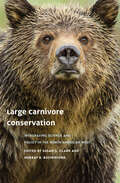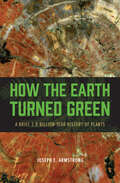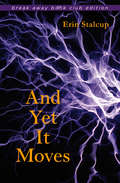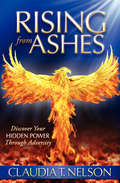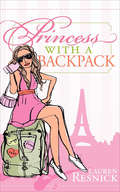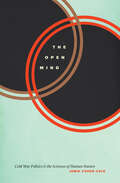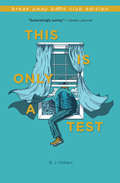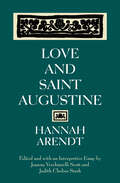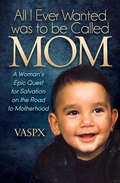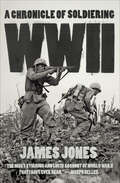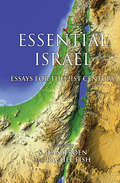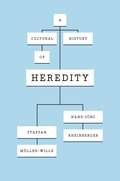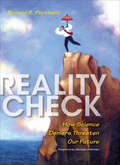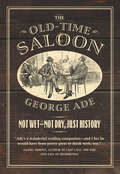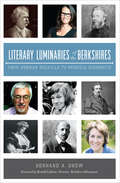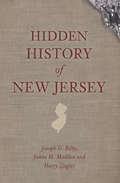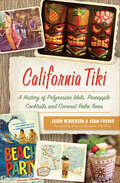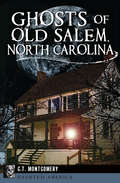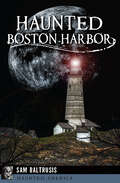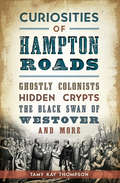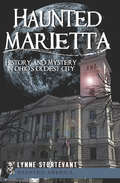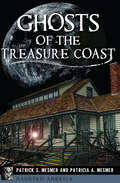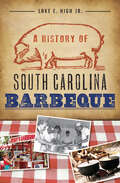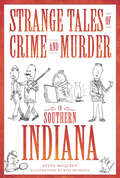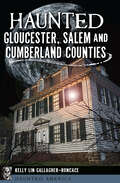- Table View
- List View
Large Carnivore Conservation: Integrating Science and Policy in the North American West
by Susan G. Clark Douglas Clark D. Scott Slocombe David J. Mattson Rebecca Watters Avery C. Anderson Linaya Workman William M. Pym Micheal L. Gibeau Seth M. Wilson Gregory A. Neudecker James J. Jonkel J. Daniel Oppenheimer Lauren Richie David N. Cherney Christina MilloyStrategies for protecting wolves, mountain lions, and more—by taking the human species into account as well: &“Very valuable.&”—Journal of Wildlife Management Drawing on six case studies of wolf, grizzly bear, and mountain lion conservation in habitats stretching from the Yukon to Arizona, Large Carnivore Conservation argues that conserving and coexisting with large carnivores is as much a problem of people and governance—of reconciling diverse and sometimes conflicting values, perspectives, and organizations, and of effective decision making in the public sphere—as it is a problem of animal ecology and behavior. By adopting an integrative approach, editors Susan G. Clark and Murray B. Rutherford seek to examine and understand the interrelated development of conservation science, law, and policy, as well as how these forces play out in courts, other public institutions, and the field. In combining real-world examples with discussions of conservation and policy theory, Large Carnivore Conservation not only explains how traditional management approaches have failed to meet the needs of all parties, but also highlights examples of innovative, successful strategies and provides practical recommendations for improving future conservation efforts. &“Building on decades of work, this book integrates biological knowledge with human dimensions study and charts a course for coexistence with large carnivores.&”—Douglas W. Smith, Senior Wildlife Biologist, Yellowstone National Park
How the Earth Turned Green: A Brief 3.8-Billion-Year History of Plants
by Joseph E. ArmstrongThis &“amazing and wonderful book&” explores the evolutionary history of photosynthesis in a grand story of how the world became the verdant place we know (Choice). On this blue planet, long before dinosaurs reigned, tiny green organisms populated the ancient oceans. Fossil and phylogenetic evidence suggests that chlorophyll, the green pigment responsible for coloring these organisms, has been in existence for some 85% of Earth&’s long history—that is, for roughly 3.5 billion years. In How the Earth Turned Green, Joseph E. Armstrong traces the history of these verdant organisms, which many would call plants, from their ancient beginnings to the diversity of green life that inhabits the Earth today. Using an evolutionary framework, How the Earth Turned Green addresses questions such as: Should all green organisms be considered plants? Why do these organisms look the way they do? How are they related to one another and to other chlorophyll-free organisms? How do they reproduce? How have they changed and diversified over time? And how has the presence of green organisms changed the Earth&’s ecosystems? With engaging prose and astonishing breadth, as well as informative diagrams and illustrations, How the Earth Turned Green demonstrates &“how the Earth blossomed into such an incredible world that most of us simply take for granted&” (San Francisco Book Review).
And Yet It Moves (Break Away Book Club Edition)
by Erin StalcupIn this debut fantasy collection &“science, physics, and electricity . . . are the background for short stories of startling human disconnection and alienation&” (ForeWord Reviews). This &“engaging collection . . . takes on the love and loneliness lurking in the bright lights and shadowed corners of the everyday&” (Kirkus Reviews). In these pages, a taboo romance breaks the laws of gravity; Albert Einstein writes letters to the daughter he abandoned; and a female physicist meets Stephen Hawking in a bar. In the closing novella, All Those Stairs, an elevator operator with a genius IQ rides up and down all day enclosed in a metal box. Author Erin Stalcup explores these lives with compassion, depth, and insight as she examines loss and longing and how our bodies and minds can be both weighted and freed. And Yet It Moves is a powerful combination of both absurdist and realist fiction. &“Simply put: these stories defy gravity&” (Zachary Tyler Vickers, author of Congratulations on Your Martyrdom!). A 2016 ForeWord Indies Finalist.
Rising from Ashes: Discover Your Hidden Power Through Adversity
by Claudia T NelsonLearn essential life lessons from a woman who refused to be a victim and discovered her true self while putting two notorious con men behind bars. No one could be prepared for the shock that Claudia Nelson faced when she learned that a Ponzi scheme had taken her entire life savings. But she refused to be a victim, and after digging deep within herself to find her true power and determination, Claudia helped hunt down and bring those responsible to justice. In light of her efforts, Forbes Magazine writer Dirk Smillie Sr., called her the &“best gumshoe vigilante I have ever met.&” In Rising from the Ashes, the acclaimed personal empowerment specialist shares her story of personal justice. She reveals practical and unique solutions that can transform life&’s most difficult challenges into positive results every day, exploring such topics as: How to find your powerful, true self by stripping away all that you are notWhy certain people are more vulnerable to being conned and abusedHow your two thought systems can work to either free you or imprison youHow to find, and dig out, the root of any problem rather than snipping away at its leaves, empowering you to transform any challenge into a blessing Engaging, entertaining and informative. Rising from Ashes is also transformative—a how-to guide for anyone who wants to overcome adversity and become all they are capable of being.
Princess with a Backpack
by Lauren ResnickA fun guide for the adventurous female traveler! With quotes, practical advice, and anecdotes from popular personalities, this travel guide helps princesses who want to leave their castles, see the world, and experience true adventure. Put on that backpack (even if it clashes with your cute outfit) and find out: How to plan your trip (without freaking out)What to wear for both comfort and styleHow to pack—for more than six months of travel timeHow to keep trim and still eat pizza in RomeEurope&’s best bars, parties, clothing stores, and accommodations—fit for a princess (all tried, tested and approved)—and more!
The Open Mind: Cold War Politics and the Sciences of Human Nature
by Jamie Cohen-ColeThis study chronicles the rise of psychology as a tool for social analysis during the Cold War Era and the concept of the open mind in American culture. In the years following World War II, a scientific vision of the rational, creative, and autonomous self took hold as an essential way of understanding society. In The Open Mind, science historian Jamie Cohen-Cole demonstrates how this notion of the self became a defining feature of Cold War culture. From 1945 to 1965, policy makers used this new concept of human nature to advance a centrist political agenda and instigate nationwide educational reforms that promoted more open, and indeed more human, minds. The new field of cognitive science was central to this project, helping to overthrow the behaviorist view that the mind either did not exist or could not be studied scientifically. While the concept of the open mind initially unified American culture, this unity started to fracture between 1965 and 1975, as the ties between political centrism and the scientific account of human nature began to unravel. During the late 1960s, feminists and the New Left repurposed psychological tools to redefine open-mindedness as a characteristic of left-wing politics. As a result, once-liberal intellectuals became neoconservative, and in the early 1970s, struggles against open-mindedness gave energy and purpose to the right wing.
This Is Only a Test (Break Away Book Club Edition)
by B. J. HollarsThe Truman Capote Prize-winning author &“provides an offbeat look at the fragility of human life and our resilience when faced with death&” (Kirkus). On April 27, 2011, just days after learning of their pregnancy, B. J. Hollars, his wife, and their future son endured the onslaught of an EF-4 tornado. There, while huddled in a bathtub in their Alabama home, mortality flashed before their eyes. With the last of his computer battery, Hollars began recounting the experience, and would continue to do so in the following years, writing his way out of one disaster only to find himself caught up in another. In this collection of personal essays, Hollars faces tornadoes, drownings, and nuclear catastrophes. These experiences force him to acknowledge the inexplicable while he attempts to overcome his greatest fear—the impossibility of protecting his newborn son from the world&’s cruelties. Through his and others&’ stories, Hollars creates a constellation of grief, tapping into the rarely acknowledged intersection between fatherhood and fear, sacrifice and safety, and the humbling effect of losing control of our lives.
Love and Saint Augustine
by Hannah ArendtThe brilliant thinker who taught us about the banality of evil explores another brilliant thinker and his concept of love. Hannah Arendt, the author of The Origins of Totalitarianism and The Human Condition, began her scholarly career with an exploration of Saint Augustine&’s concept of caritas, or neighborly love, written under the direction of Karl Jaspers and the influence of Martin Heidegger. After her German academic life came to a halt in 1933, Arendt carried her dissertation into exile in France, and years later took the same battered and stained copy to New York. During the late 1950s and early 1960s, as she was completing or reworking her most influential studies of political life, Arendt was simultaneously annotating and revising her dissertation on Augustine, amplifying its argument with terms and concepts she was using in her political works of the same period. The dissertation became a bridge over which Arendt traveled back and forth between 1929 Heidelberg and 1960s New York, carrying with her Augustine's question about the possibility of social life in an age of rapid political and moral change. In Love and Saint Augustine, political science professor Joanna Vecchiarelli Scott and philosophy professor Judith Chelius Stark make this important early work accessible for the first time. Here is a completely corrected and revised English translation that incorporates Arendt&’s own substantial revisions and provides additional notes based on letters, contracts, and other documents as well as the recollections of Arendt's friends and colleagues during her later years. &“Both the dissertation and the accompanying essay are accessible to informed lay readers. Scott and Stark's conclusions about the cohesive evolution of Arendt&’s thought are compelling but leave room for continuing discussion.&”—Library Journal &“A revelation.&”—Kirkus Reviews
All I Ever Wanted was to be Called Mom: A Woman's Epic Quest for Salvation on the Road to Motherhood
by VASPXA couple takes readers on an emotional roller-coaster ride through the ups and downs of their experience with IVF and pregnancy. This is a true-life story of a woman&’s turbulent journey towards motherhood—told from the perspective of both husband and wife—as they struggle with the emotional and financial toll the IVF process takes on their relationship. When she was dreaming of creating life, she encountered death and battle for the survival of her very family. When she wanted to be called mom, she faced fears and problems of immense proportions. It is a story of pain and despair, but also of faith and hope. All I Ever Wanted Was to Be Called Mom is a celebration of women—their resilience, their courage, and their strength in building the future of their dreams.
WWII: A Chronicle of Soldiering
by James JonesThis &“unique and fascinating&” WWII memoir by the acclaimed author of From Here to Eternity and The Thin Red Line &“stands out as one of the most vivid&” (The Wall Street Journal). In 1975, James Jones was chosen to write the text for an oversized coffee table book featuring visual art from World War II. The book was a best seller, praised for both its images and for Jones&’s text. In subsequent decades, when it became impossible to reproduce the book with its original artwork, it fell out of print and was forgotten. But now, this edition of WWII makes Jones&’s stunning text—his only extended nonfiction writing on the war—available once again. Moving chronologically and thematically through the complex history of World War II, Jones interweaves his own vivid memories of soldiering in the Pacific—from the look on a Japanese fighter pilot&’s face as he bombed Pearl Harbor, so close that Jones could see him smile and wave, to hitting the beach under fire in Guadalcanal—while always returning to resounding larger themes. While much of WWII is a tribute to the commitment of American soldiers, Jones also pulls no punches when recounting questionable strategic choices, wartime suffering, disorganization, the needless loss of life, and the brutal realization that a soldier is merely a cog in a heartless machine
Essential Israel: Essays for the 21st Century (Perspectives on Israel Studies)
by Gil Troy Michael Brenner David Ellenson Maoz Azaryahu Alan Dowty Donna Robinson Divine Yaakov Ariel Rachel S. Harris Ranen Omer-Sherman David Makovsky Arnon Golan Yedidia Stern Steven Bayme Norman Stillman&“An excellent tool in Middle Eastern politics classes [and] an intellectual resource for experts who want to learn more about the complexities of Israel.&”—Reading Religion Americans debate constantly about Israel, its place in the Middle East, and its relations with the United States. Essential Israel examines a wide variety of complex issues and current concerns in historical and contemporary contexts to provide readers with an intimate sense of the dynamic society and culture that is Israel today, providing a broader and deeper understanding to inform the conversation. The expert contributors to this volume address the Arab-Israeli conflict, the state of diplomatic efforts to bring about peace, Zionism and the impact of the Holocaust, the status of the Jewish state and Israeli democracy, foreign relations, immigration and Israeli identity, as well as literature, film, and the other arts. This unique and innovative volume provides solid grounding to understandings of Israel&’s history, politics, culture, and possibilities for the future.
A Cultural History of Heredity
by Hans-Jörg Rheinberger Staffan Müller-Wille&“Thought-provoking…any scientist interested in genetics will find this an enlightening look at the history of this field.&”—Quarterly Review of Biology It was only around 1800 that heredity began to enter debates among physicians, breeders, and naturalists. Soon thereafter, it evolved into one of the most fundamental concepts of biology. Here, Staffan Muller-Wille and Hans-Jorg Rheinberger offer a succinct cultural history of the scientific concept of heredity. They outline the dramatic changes the idea has undergone since the early modern period and describe the political and technological developments that brought about these changes. They begin with an account of premodern theories of generation, showing that these were concerned with the procreation of individuals rather than with hereditary transmission, and reveal that when hereditarian thinking first emerged, it did so in a variety of cultural domains, such as politics and law, medicine, natural history, breeding, and anthropology. The authors then track theories of heredity from the late nineteenth century—when leading biologists considered it in light of growing societal concerns with race and eugenics—through the rise of classical and molecular genetics in the twentieth century, to today, as researchers apply sophisticated information technologies to understand heredity. What we come to see from this exquisite history is why it took such a long time for heredity to become a prominent concept in the life sciences, and why it gained such overwhelming importance in those sciences and the broader culture over the last two centuries.
Reality Check: How Science Deniers Threaten Our Future
by Donald R. ProtheroA thought-provoking look at science denialism &“for popular science readers who want better to be able to explain and defend science and scientific methods to others&” (Library Journal). The battles over evolution, climate change, childhood vaccinations, and the causes of AIDS, alternative medicine, oil shortages, population growth, and the place of science in our country—all are reaching a fevered pitch. Many people and institutions have exerted enormous efforts to misrepresent or flatly deny demonstrable scientific reality to protect their nonscientific ideology, their power, or their bottom line. To shed light on this darkness, Donald R. Prothero explains the scientific process and why society has come to rely on science not only to provide a better life but also to reach verifiable truths no other method can obtain. He describes how major scientific ideas that are accepted by the entire scientific community (evolution, anthropogenic global warming, vaccination, the HIV cause of AIDS, and others) have been attacked with totally unscientific arguments and methods. Prothero argues that science deniers pose a serious threat to society, as their attempts to subvert the truth have resulted in widespread scientific ignorance, increased risk of global catastrophes, and deaths due to the spread of diseases that could have been prevented. &“Prothero&’s treatise will give the science-minded something to cheer about, a brief summary of the real data that supports so many critical aspects of modern life.&” —Publishers Weekly
The Old-Time Saloon: Not Wet - Not Dry, Just History
by George AdeA celebration of the nineteenth-century saloon, written with sly humor during Prohibition: &“A gem for gentlemen and gentlewomen who enjoy a tipple.&”—Toronto Star Described by Luc Sante as &“a distant ancestor of Rocky and Bullwinkle,&” George Ade was an early twentieth-century humorist beloved by many, even earning praise from H.L. Mencken. During the waning years of Prohibition, he wrote The Old-Time Saloon—both a work of propaganda masquerading as &“just history&” and a hilarious exercise in nostalgia that let booze-deprived readers of the day know just what they were missing. Featuring original, vintage illustrations along with a new introduction and notes from Bill Savage, Ade&’s book takes us back to the long-gone men&’s clubs of earlier days, when beer was a nickel, the pretzels were polished, and the sardines were free. &“Ade amuses with his dry humor on a wet topic…The book discusses every phase of the saloon and every type of saloon, from the ornate and opulent place, like the Waldorf or the Knickerbocker, to the dive on the corner and the old-fashioned roadhouse.&”—Brooklyn Daily Eagle &“Much about nineteenth-century saloons may have been sordid and squalid, but Ade knew how to find their charm, even their joy. He&’s a wonderful reading companion—and I bet he would have been pretty great to drink with, too.&”—Daniel Okrent, author of Last Call
Literary Luminaries of the Berkshires: From Herman Melville to Patricia Highsmith
by Bernard A. DrewThe literary history behind this beautiful mountain region. The Massachusetts Berkshires have long been a mecca for literary greats, from Henry Wadsworth Longfellow and Edith Wharton to Sinclair Lewis and Joan Ackermann. The Green River in Great Barrington inspired William Cullen Bryant&’s poetry. Charles Pierce Burton&’s childhood hometown, Adams, became the setting for his frolicking Boys of Bob&’s Hill children&’s books. During an interlude in Lenox, Patricia Highsmith consulted a local undertaker for details to use in The Talented Mr. Ripley. In this book, Bernard A. Drew brings together a fascinating chronicle of some 250 wordsmiths who took inspiration from the hills and valleys of the Berkshires.
Hidden History of New Jersey (Hidden History Ser.)
by Harry Ziegler Joseph G. Bilby James M. MaddenThe obscure people and events that helped make the Garden State the place it is today—from ghosts to governors, battles to boardwalk attractions. Explore the lesser-known stories that make up New Jersey&’s compelling hidden history. Uncover the meaning of &“Jersey Blues,&” celebrate some of the state&’s bravest Revolutionary and Civil War soldiers, and investigate Jersey City&’s most infamous ghost. From the inferno that engulfed Asbury Park to the benevolent side of Frank Hague to the equestrienne who plunged forty feet into a pool of water on horseback in Atlantic City, rediscover these and many other events from New Jersey&’s storied past. Includes photos!
California Tiki: A History of Polynesian Idols, Pineapple Cocktails and Coconut Palm Trees
by Jason Henderson Adam FoshkoThe fascinating story behind California&’s mid-twentieth century obsession with all things Polynesian and Hawaiian. After World War II, suburbs proliferated around California cities as returning soldiers traded in their uniforms for business suits. After-hours leisure activities took on an island-themed sensuality that bloomed from a new fascination with Polynesia and Hawaii. Movies and television shows filmed in Malibu and Burbank urged viewers to escape everyday life with the likes of Elvis, Gidget, and Hawaiian Eye. Restaurants like Don the Beachcomber and Trader Vic&’s sprang up to answer the demand for wild cocktails and even wilder décor. A strange hodgepodge of idols, lush greenery and colorful drinks, Tiki beckoned men and women to lose themselves in exotic music and surf tunes. Take a trip back in time to the scene of Polynesian pop and three decades of palm trees, Mai Tais, and torches with this informal guide to the rise, fall, and resurgence of Tiki culture.
Ghosts of Old Salem, North Carolina (Haunted America)
by G.T. MontgomeryStories and photos that reveal the paranormal history of this picturesque Winston-Salem district. Hidden behind the preserved eighteenth-century colonial buildings of the Old Salem Historic District in Winston-Salem is a haunted history of spine-tingling tales . . . Find the harrowing stories of Salem Cemetery and the anonymous headstones of the &“Strangers&’ Graveyard.&” Learn the origins of the inexplicable sounds at Salem College. Meet the tavern traveler who refuses to check out. Follow the story of Andreas Kresmer&’s tragic death and the subsequent appearance of the &“Little Red Man.&” In this book, author G.T. Montgomery takes you on a frightening and fascinating journey to discover the most notorious haunts to wander Salem&’s streets.
Haunted Boston Harbor (Haunted America)
by Sam BaltrusisMeet the spirits who lurk in the waters near this historic seaport and its secluded islands—photos included! Boston Harbor brims with the restless spirits of pirates, prisoners, and victims of disease and injustice. Uncover the truth behind the Lady in Black on Georges Island. Learn about the former asylums on Long Island that inspired the movie Shutter Island, and dig up the skeletal secrets left behind by the Woman in Scarlet Robes. From items flying off the shelves at a North End cigar shop to the postmortem cries of tragedy at the centuries-old Boston Light on Little Brewster, author Sam Baltrusis breathes new life into the horrors that occurred in the historic waters surrounding Boston.
Curiosities of Hampton Roads: Ghostly Colonists, Hidden Crypts, the Black Swan of Westover, and More
by Tamy Kay ThompsonFacts and photos highlighting the haunting side of Virginia&’s Tidewater . . . The history of Hampton Roads is as deep as the waters that surround it. From some of the first settlers in the New World to the formation of the nation, Virginia&’s Tidewater is rich in curious tales of legends and lore. In the Southside, the famed pirate Blackbeard was beheaded by Captain Maynard of Hampton. Captain John Smith was a part of the first governing body in America formed in Jamestown. The nation&’s oldest mental institution still stands in Williamsburg. Staff and guests at Boxwood Inn in Newport News have reported hauntings from a former owner and other eerie occurrences. In this offbeat travel guide, author Tamy Kay Thompson covers these stories and more as she takes readers on a journey through the always entertaining past of Hampton Roads.
Haunted Marietta: History and Mystery in Ohio's Oldest City (Haunted America)
by Lynne SturtevantFrom burial mounds to haunted hotels, fugitives to river phantoms, Ohio&’s first settlement is number-one in paranormal activity. Haunted Marietta: History and Mystery in Ohio&’s Oldest City explores the supernatural side of the state&’s first settlement. Visit a crumbling mansion from 1855, whose original owner still roams the halls; sit in the plush red seats of an abandoned theatre; and climb an ancient Indian burial mound. Encounter river pirates, fugitive slaves, an axe murderer, jealous lovers, and inept morticians. Haunted Marietta delves into various types of otherworldly phenomena, examines the difference between ghost stories and reports of supernatural activity, and discusses why certain people become spirits. From an 1815 goblin sighting to a bartender&’s brush with the unexplained, local author Lynne Sturtevant covers it all. Includes photos!
Ghosts of the Treasure Coast (Haunted America)
by Patrick S. Mesmer Patricia A. Mesmer&“Spooky tales of vanished sailors, wandering phantoms and lost treasure scattered across the ocean floor&” from Florida&’s husband and wife ghost hunters (TCPalm). The Treasure Coast is such a popular destination that some choose to never leave. From the spirits of ancient Indians who once inhabited the beaches to the pirates who spied for passing victims from the safety of the inlets and coves, the region is infused with eerie, tragic history. A phantom widow keeps watch from the Boston House window for men long ago lost at sea. Spirits of the victims of a murderous cop linger at the Devil&’s Tree, where their bodies were found. The dreaded pirate Black Caesar still steers his ghost ship toward Dead Man&’s Point in the St. Lucie Inlet. Authors Patrick and Patricia Mesmer navigate through spooky tales of vanished sailors, wandering phantoms and lost treasure scattered across the ocean floor. Includes photos!
A History of South Carolina Barbeque (American Palate Ser.)
by Lake E. High Jr.&“The guru of &’que . . . [is] well equipped for his mission: securing South Carolina&’s rightful claim as home to the nation&’s first and best barbeque&” (South Carolina Living). South Carolina has been home to good, old-fashioned barbeque for quite a long time. Hundreds of restaurants, stands and food trucks sell tons of the southern staple every day. But the history of Palmetto State barbeque goes deeper than many might believe—it predates the rest of America. Native Americans barbequed pork on makeshift grills as far back as the 1500s after the Spanish introduced the pig into the Americas. Since the early 1920s, South Carolinians have been perfecting the craft and producing some of the best-tastin&’ &’que in the country. Join author and president of the South Carolina Barbeque Association Lake E. High Jr. as he traces the delectable history from its pre-colonial roots to a thriving modern-day tradition that fuels an endless debate over where to find the best plate. Includes photos! &“Of course, if one wants to taste the best, one needs to eat barbecue in South Carolina. As High repeatedly thumps into readers, the South, and South Carolina in particular, is home to real barbecue. Nevermind that hippie California TV-producer gobbledegook or those misguided cooking attempts by confused Northerners. Bless their hearts.&” —The Island Packet
Strange Tales of Crime and Murder in Southern Indiana (Murder And Mayhem Ser.)
by Keven McQueenThe author of Horror in the Heartland delves deep into the dark and sordid annals of the region where Hoosier history began. Prepare to take a tour of some dark, strange moments of southern Indiana&’s history. From the scheming wife who wanted her dull husband out of the way to make room for a young love affair and the husband who stomped his wife to death because she wouldn&’t stop singing an irritating song, to the man who murdered an entire family to pay off some farming equipment and the case of a mistaken-identity murder, author Keven McQueen relates the sinister (or not so) motives and gruesome details of nine murders that occurred in southern Indiana between 1880 and 1912. With a detailed, if macabre, look at each story as well as the ambiguities surrounding the criminals and punishments, McQueen illuminates the darker side of Hoosier history. Includes photos!
Haunted Gloucester, Salem and Cumberland Counties (Haunted America)
by Kelly Lin Gallagher-RoncaceThe Jersey Devil isn&’t the only supernatural entity that stalks the Garden State: Here are tales of pirates, patients, and prisoners, oh my! Few places are as obsessed with the paranormal as New Jersey, and the area once known as West Jersey is a hotbed of supernatural activity. The ghost of a young boy in Mannington appears to welcome guests and partygoers to a historic bed-and-breakfast. The tortured soul of a weathered sea pirate remains in Greenwich, still imprisoned after three hundred years. Malevolent spirits haunt the abandoned Salem County Insane Asylum, menacing those who dare venture to the solitary confinement rooms in the basement. Paranormal investigator and researcher Kelly Lin Gallagher-Roncace shares frightening New Jersey folklore that makes for great fireside storytelling. Includes photos! &“During Gallagher-Roncace&’s time as a reporter for the South Jersey Times, she created a weekly column called &‘Paranormal Corner,&’ where she would divulge into anything &‘weird&’— UFOs, Bigfoot, Jersey Devils and hauntings. Through her exploration with her paranormal investigation group Jersey Unique Minds Paranormal Society — also known as JUMPS — she experienced &‘the feels&’ for the first time in the old Bunker Hill Presbyterian Church.&” —The Washington Township Sun
